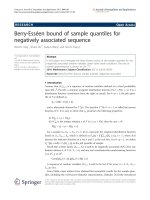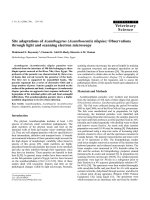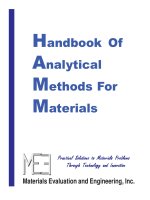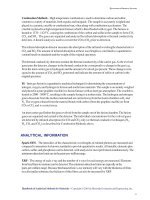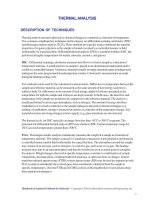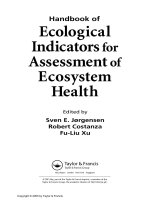handbook of sample preparation for scanning electron microscopy and x ray microanalysis
Bạn đang xem bản rút gọn của tài liệu. Xem và tải ngay bản đầy đủ của tài liệu tại đây (5.47 MB, 343 trang )
Handbook of Sample Preparation for Scanning
Electron Microscopy and X-Ray Microanalysis
Handbook of Sample
Preparation for
Scanning Electron
Microscopy and X-Ray
Microanalysis
Patrick Echlin
Cambridge Analytical Microscopy, UK
Patrick Echlin
Cambridge Analytical Microscopy, UK
ISBN: 978-0-387-85730-5
e-ISBN: 978-0-387-85731-2
DOI: 10.1007/978-0-387-85731-2
Library of Congress Control Number: 2008942785
© Springer Science+Business Media, LLC 2009
All rights reserved. This work may not be translated or copied in whole or in part without the written permission of
the publisher (Springer Science+Business Media, LLC, 233 Spring Street, New York, NY 10013, USA), except for brief
excerpts in connection with reviews or scholarly analysis. Use in connection with any form of information storage
and retrieval, electronic adaptation, computer software, or by similar or dissimilar methodology now known or
hereafter developed is forbidden.
The use in this publication of trade names, trademarks, service marks, and similar terms, even if they are not identified
as such, is not to be taken as an expression of opinion as to whether or not they are subject to proprietary rights.
While the advice and information in this book are believed to be true and accurate at the date of going to press, neither the authors nor the editors nor the publisher can accept any legal responsibility for any errors or omissions that
may be made. The publisher makes no warranty, express or implied, with respect to the material contained herein.
Printed on acid-free paper
springer.com
For Alexander, Charles, Patrick, Francesca, Maeve,
and William in the fond hope that some of them might
become scientists.
I am dedicating this book to my six grandchildren
and thanking a lot of people for their help and, finally for my wife's
patience over the past five years.
Books must follow science, and not science books.
–Francis Bacon, 1657
Acknowledgments
This book would not have been possible without the help of many
people. I am privileged to have been working in this field for the
past 45 years and am indebted to the many friends and colleagues
from all over the world who have listened to my ideas, corrected my
errors, and provided practical advice. I am also grateful to the many
people and manufacturers who have provided information and
illustrations for this book and who are acknowledged in the text.
I am particularly grateful to my colleagues with whom I have
taught at the Lehigh Microscopy School for the past 32 years.
They have been a constant source of enlightenment and their
constructive and critical analysis of my work and writings has
been very supportive.
Finally, gratitude to Joe Michael for the use of one of his micrographs as a cover illustration for this book.
Patrick Echlin
Cambridge, January 2009
ix
Contents
Acknowledgments ........................................................................
ix
Chapter 1
Introduction ............................................................
1
Chapter 2
Sample Collection and Selection .......................
11
Chapter 3
Sample Preparation Tools ....................................
19
Chapter 4
Sample Support .....................................................
31
Chapter 5
Sample Embedding and Mounting ...................
47
Chapter 6
Sample Exposure ...................................................
65
Chapter 7
Sample Dehydration .............................................
97
Chapter 8
Sample Stabilization for Imaging
in the SEM...............................................................
137
Sample Stabilization to Preserve
Chemical Identity ..................................................
185
Chapter 10
Sample Cleaning ...................................................
235
Chapter 11
Sample Surface Charge Elimination..................
247
Chapter 12
Sample Artifacts and Damage ............................
299
Chapter 13
Additional Sources of Information....................
307
References.......................................................................................
317
Index ................................................................................................
323
Chapter 9
xi
1
Introduction
Scanning electron microscopy (SEM) and x-ray microanalysis can
produce magnified images and in situ chemical information from
virtually any type of specimen. The two instruments generally
operate in a high vacuum and a very dry environment in order to
produce the high energy beam of electrons needed for imaging and
analysis. With a few notable exceptions, most specimens destined
for study in the SEM are poor conductors and composed of beam
sensitive light elements containing variable amounts of water.
In the SEM, the imaging system depends on the specimen being
sufficiently electrically conductive to ensure that the bulk of the
incoming electrons go to ground. The formation of the image
depends on collecting the different signals that are scattered
as a consequence of the high energy beam interacting with the
sample.
Backscattered electrons and secondary electrons are generated
within the primary beam-sample interactive volume and are the
two principal signals used to form images. The backscattered
electron coefficient (η) increases with increasing atomic number
of the specimen, whereas the secondary electron coefficient (δ) is
relatively insensitive to atomic number. This fundamental difference in the two signals can have an important effect on the way
samples may need to be prepared. The analytical system depends
on collecting the x-ray photons that are generated within the
sample as a consequence of interaction with the same high
energy beam of primary electrons used to produce images.
1. The use of scanning electron microscopy and x-ray microanalysis may be considered under three headings.It is first
necessary to understand the actual process of microscopy and
analysis. This is not considered here in any detail because my
colleagues and I have produced an excellent textbook that
covers these processes in great detail (Goldstein et al., 2004).
P. Echlin, Handbook of Sample Preparation for Scanning Electron Microscopy
and X-Ray Microanalysis, DOI: 10.1007/978-0-387-85731-2_1,
© Springer Science + Business Media, LLC 2009
1
2
1. Introduction
2. It is necessary to consider how to prepare samples prior to
microscopy and analysis. These procedures are the topic of
this book.
3. It is necessary to be able to interpret the information obtained
from the SEM and attempt to relate the form and structure
of the two-dimensional images and the identity, validity, and
location of the chemical data back to the three-dimensional
sample from which the information was derived. This is a
topic of continuing debate.
There are two approaches to dealing with the frequent impasse
that may exist between the properties of the sample and the
optimal operating conditions of the SEM. We can either modify
the instruments so they employ less invasive procedures or we
can modify the specimen to make it more robust to the withering
beam of high energy electrons. The former approaches are discussed in the book by Goldstein et al. (2004); the latter approach
is considered here. With a few exceptions, both approaches are a
compromise.
Sample preparation is an absolute prerequisite for microscopy
and analysis.
Every specimen that goes into the SEM needs some form of
sample preparation. There are no exceptions.
Consider carrying out microscopy and analysis on the components at our breakfast table. After drinking our fresh orange juice,
we use a knife to butter our toast before we drink our coffee. The
glass containing our juice is composed of a beam resistant, nonconducting, non-crystalline, light element solid. The orange juice
and the coffee are wet, non-conducting, biopolymer composed of
light element materials that are very bean sensitive. The buttered
toast is a thermally and beam sensitive, non-conducting, damp,
light element biopolymer. The knife is made of a beam resistant
conducting metal that, in spite of being washed, is dirty. The
plastic plate is made of a beam sensitive, non-conducting, light
element polymer and the coffee cup is a beam resistant, nonconducting inorganic ceramic. All of these objects need some form
of preparation before they may be examined properly by scanning
electron microscopy and x-ray microanalysis.
The preceding example shows that there is a very wide range of
specimen types. For convenience they are divided into six groups
on the basis that each group has distinct characteristics, and as a
consequence, may require different approaches to sample preparation. This sixfold division is somewhat artificial because many
specimens are composed of material from more than one of these
groups. For example, a human tooth is composed of hard dry,
inorganic material in a biological matrix, a car tire is a mixture of
metal and polymers, and deep sea oil is a mixture of brine, mud,
and organic material. The six groups are as follows.
1.2 Hard, Dry, Inorganic Materials
1.1 Metals, Alloys, and Metallic Materials
These types of samples occur naturally either as metals or mineral ores and as fabricated components such as nanowires and
microwires, cables, sheets, girders, and complex structures such
as automobiles and televisions. Metals range in atomic weight
from the depleted uranium (Z = 92) component of artillery
ordnance, to beryllium (Z = 4) used for specimen stubs. Metals
are dry and good conductors of electricity and heat ranging
from the high conductivity of silver to the low conductivity of
alloys such as Nichrome. They are generally chemically stable
and resistant to radiation damage in the microscope column
(Figure 1.1).
1.2 Hard, Dry, Inorganic Materials
This important group of samples are generally chemically stable but are all poor electrical conductors. The type of specimens
includes ceramics, rocks, geological samples, minerals, particles, microelectronic devices, optoelectronic communication
systems, integrated circuits, package devices, and fibers. The
group also contains a wide range of manufactured materials
such as microelectronic devices, concrete, cement and other
building materials, concentrated ores, and glass. Fossil bones
and teeth may fall into this category provided they are devoid
of significantly important moisture and/or organic material.
Living or recently dead bones and teeth are better considered as
Figure 1.1. A steel rail tie from the old Colorado Midland Railroad track
(1883–1918) near the Hageman Tunnel in Colorado at 3600m, 1980
3
4
1. Introduction
Figure 1.2. Serpentine sculpture “Warming myself” by Zachariah
Njobo, Zimbabwe, 1999
biological material. Some specimens such as clays, soils, mud,
and suspended particles, contain varying amounts of water
that must either be removed by drying or converted at sub-zero
temperatures to the solid state. This second group of specimens
are generally composed of low atomic number materials (Z =
1–20) and are resistant to radiation damage in the microscope
column. Provided they are dry, the samples are generally chemically stable but are all poor conductors (Figure 1.2).
1.3 Hard or Firm, Dry Natural Organic Materials
This category consists of polymers of carbohydrates, proteins,
and fat derived from living organisms. Close to 99% of the
chemical composition of all living material is formed from the
low atomic number material (Z = 1–20) and include the major
elements (H, C, N, O) and minor elements (Na, Mg, Si, P, S., Cl,
K, and Ca). The remaining 1% is made up primarily of Z = 24
to Z = 30 and includes the trace elements Cr, Co, Cu, Fe, Mn,
Zn, and I, which are important in various metalloenzymes and
coenzymes.
The type of samples allocated to this group include wood and
its derived products including timber, furniture, and paper;
dried seeds and their manufactured powders, some foods, and
plant fibers that form the basis of rope, string, threads, textiles,
and fabrics. This category also includes hair, leather, wool, and
skin, which are composed of complex polymers of proteins and
solid waxes derived from fats. These are all derived materials,
1.5 Biological Organisms and Materials
Figure 1.3. Nineteenth century Kilim Prayer Rug. Kapadokya, Turkey,
1976
and although they all are susceptible to varying degrees of
hydration, chemical destruction, and biological decay, they do
not readily form chemical bonds with small molecules. They are
poor conductors and are susceptible to radiation damage. Some
specimens are easily wetted; others are very resistant to water
(Figure 1.3).
1.4 Synthetic Organic Polymer Materials
The primary feed stock for these synthetic polymers are natural
oil, gas, and coal, which provide the source for ethylene, methane, alkenes, and aromatic compounds, and which in turn provide the building blocks for polymers, paints, and plastics. They
are hydrocarbons composed of hydrogen and carbon (Z = 1–8)
and have a wide range of everyday applications in the production of fibers, films, membranes, adhesives, elastomers, and
engineering and construction polymers. Manufactured polymers
also may exist as composites containing minerals, glass, and metals. They are not readily wetted, and are usually more resistant
to hydration and chemical destruction than the previous group
of dry natural organic materials. As a group they are very poor
conductors and are more susceptible to radiation damage than
the previous group of samples (Figure 1.4).
1.5 Biological Organisms and Materials
These are living organisms, and they are composed primarily
of light elements (Z = 1–20), which also contain a large number
5
6
1. Introduction
Figure 1.4. Plastic orange juicer
Figure 1.5. Polyanthus flowers. Cambridge, 2008
of trace elements. Water is an essential component of living biological samples, together with complex organic macromolecules
such as proteins, lipids, and carbohydrates. They are susceptible
to dehydration, chemical destruction, and biological decay. They
are poor conductors and very susceptible to radiation damage
(Figure 1.5).
1.6 Wet and Liquid Samples
1.6 Wet and Liquid Samples
This group of samples, although unique, is a subset of the previous five samples. They are included here as a separate group
because their liquids are an essential part of their form, structure
and chemistry.
Wet samples are defined as specimens that do not flow and have a
readably recognizable structural integrity at normal temperatures
and pressures. For example, a drilled rock sample from an oil
field, a fresh leaf, or freshly mixed concrete.
Liquid samples will flow and lack any readably recognizable
structure at normal temperatures and pressures; for example,
paint, mud, and milk (and beer).
In both types of sample the most prominent liquid is water,
but anhydrous oils, emulsions, inorganic and organic solutions,
and suspensions are found in the natural state of many different
specimens. These are the most challenging group of samples to
prepare for although there are specialist devices to directly examine wet samples in the SEM, most microscopy and analysis is carried out on dry samples. The liquid components are exclusively
composed of light elements and are very susceptible to conventional drying and chemical activity. The liquids are poor conductors and very susceptible to radiation damage (Figure 1.6).
This book is designed as an introduction to sample preparation and will not contain recipes for every type of specimen.
The approach is to bridge the gap between the properties of the
specimen and the exigencies of the SEM and provide a general
Figure 1.6. Wet yogurt and and beer, 2008
7
8
1. Introduction
way to prepare the sample. This general approach is continually
interspersed with additional more specific information to which
readers are directed in the scientific literature.
It is intended to discuss in general terms, twelve different
activities that are involved in sample preparation arranged in the
sequence they would normally be expected to occur during sample
preparation. It will be made clear where there are notable differences to this sequence. For example, metals and dry inorganic
samples may need repeated cleaning.
Prior to designing any sample preparation, it is necessary
to clearly establish the scientific questions to be answered and
whether scanning electron microscopy and x-ray microanalysis
are the most appropriate instrumentations to use. At this preliminary stage it is useful to assemble as much chemical and structural information as possible about the specimen available from
other sources. As most samples are multiphase, it is probably best
either to design the preparative procedures to accommodate the
most fragile component or set out different procedures for each
of the different components. For example, a plastic insert in a
metal rod might need two procedures and the metal and plastic
knee replacement in my left leg might need three or even four
methods.
The first chapter considers the collection and selection of the
sample to ensure it is given a unique identity code that will
follow it through the whole procedure of preparation, examination, analysis, and eventual storage. It is necessary to know the
dimensions of the specimen stage inside the microscope, as this
will determine the size, shape, and form of the specimen to be
studied.
The second chapter considers what tools and equipment are
needed to prepare the specimen. These can vary from large diamond saws to fine forceps and from freeze dryers to toothpicks.
Usually the specimen and proposed investigation dictate the
type of instruments that are needed to image and analyze the
sample.
The third chapter discusses the different ways samples may be
supported in the microscope.
The fourth chapter considers the ways different types of samples may be embedded in, or mounted on, the chosen specimen
support.
The fifth chapter provides information about the different
ways the region of interest in the sample may be exposed for
microscopy and, if necessary, polished for x-ray microanalysis.
The sixth chapter gives details of the different processes that
may be used to dehydrate the sample and ensure it is dry when
it is placed in the microscope.
The seventh chapter discusses how delicate samples may be
stabilized to enable them to be imaged in the microscope.
1.6 Wet and Liquid Samples
The eighth chapter considers how any of the six types of samples may be treated to preserve their chemical identity as well as
their structure.
The ninth chapter describes the different ways to ensure the
sample is clean and free of any materials that will either obscure
the surface image and/or compromise its chemical identity.
The tenth chapter provides details of all the methods that may
be used to ensure the sample is electrically conductive inside the
microscope column.
The eleventh chapter addresses the problems associated with
recognizing artifacts and damage that may arise during sample
preparation.
The final chapter provides a compendium of additional continuing oral and written information about new developments in
sample preparation.
Ideally, once sample preparation is completed the specimen
should be immediately placed into the microscope for imaging
and analysis. If this is not possible, it should be stored in a clean,
dry, secure environment for examination at a later date. All that
remains now is to study the specimen—but that is another story.
9
2
Sample Collection and Selection
Before considering the different aspects of specimen preparation,
it is first necessary to understand some general features of
the sample and the scanning electron microscope (SEM). This
involves collecting and selecting the samples in order to establish
their optimal form and dimensions for examination in a particular scanning electron microscope.
2.1 Sample Collection
Usually sample collection is not a problem as investigators bring
their samples to the laboratory, but it is necessary to consider the
problems involved in collecting and transporting specimens to
the microscope. It is important to try to collect a representative
sample; for specimens 1 mm3 or smaller, the best approach is to
collect several items. Large specimens may present a problem,
and the best that can be done is to take a photograph of the
whole sample to show what part of it was collected. For most
inert dry samples, such as metals, rocks, geological specimens,
wood, paper, fabrics, seeds, and most plastic and polymer specimens, it is only necessary to carefully wrap the specimen in clean
dry material and place it into a secure well-labeled container.
Powders, soils, and fine metal filings are more conveniently
collected in clean containers or plastic bottles. More delicate
samples should be wrapped in several layers of fine dry tissue.
At this stage, no attempt should be made to clean the specimen
other than to remove any excess surface liquid.
Biological samples and wet samples present a number of problems, and the aim should be to collect and maintain them in their
natural state. Aquatic organisms should be kept in their natural
environment, terrestrial specimens are best maintained in a
damp environment, and dry material should be loosely wrapped
P. Echlin, Handbook of Sample Preparation for Scanning Electron Microscopy
and X-Ray Microanalysis, DOI: 10.1007/978-0-387-85731-2_2,
© Springer Science + Business Media, LLC 2009
11
12
2. Sample Collection and Selection
in soft tissue. Dissected material should be gently covered with
surgical gauze. These types of samples should be kept, ventilated
or aerated if necessary, in secure well-labeled containers.
Wet and liquid specimens should be maintained in their
natural state in sealed containers made of either plastic or glass.
Frozen samples, such as ice cream, should be collected and kept
under liquid nitrogen or dry ice and brought back to the laboratory. One of the most remarkable low temperature collecting
and transport devices was that devised by scientists at British
Antarctic Survey to enable them to collect polar ice and snow
and transport the intact precipitation back to their laboratory in
Cambridge, England.
The key to these collection and transport procedures is to maintain the sample in a condition as close as possible to its natural
environment and speedily transport it to the microscope.
2.2 Sample Selection
It is necessary to consider the parameters that govern selecting
a suitable sample for examination in the SEM. Size, shape, and
proposed sample examination need to be considered.
2.2.1 Internal Dimensions of the SEM Specimen Chamber
The specimen chamber of the SEM is much larger than the specimen region of a transmission electron microscope (TEM). Some
SEM stages can accommodate and image over the whole area of
an 8-in. wafer and even a hamburger, as shown in Figure 2.1.
Figure 2.1. Picture of a hamburger. Picture courtesy of John Mansfield,
University of Michigan, Ann Arbor, MI

